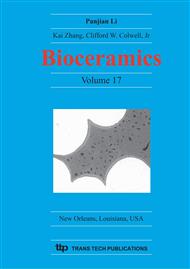p.435
p.439
p.445
p.449
p.453
p.457
p.461
p.465
p.469
Surface Charge of Bioactive Polyethylene Modified with –SO3H Groups and Its Apatite Inducing Capability in Simulated Body Fluid
Abstract:
A bioactive polyethylene polymer substrate can be produced by incorporation of sulfonic functional groups (-SO3H ) on its surface. Variation of the surface potential of the polyethylene modified with -SO3H groups with soaking in SBF were investigated using a laser electrophoresis zeta-potential analyzer. To complement the study using the laser electrophoresis, the surface was examined by X-ray photoelectron spectroscopy (XPS) and scanning electron microscopy with an attached energy dispersive electron probe X-ray analyser (FE-SEM/EDS). It was found that the surface potential of the polyethylene was highly negative charged after soaking in SBF for 0.5 h, increased for higher soaking times (up to 48 h), and then decreased. The negative charge of the polymer at soaking time of 0.5 h is attributed to the presence of –SO3H groups on the surface. The initial increase in the surface potential was attributed to the incorporation of positively charged calcium ions to form a calcium sulphate, and then the subsequent decrease was assigned to the incorporation of negatively charged phosphate ions to form an amorphous calcium phosphate, which eventually transformed into apatite.
Info:
Periodical:
Pages:
453-456
Citation:
Online since:
April 2005
Price:
Сopyright:
© 2005 Trans Tech Publications Ltd. All Rights Reserved
Share:
Citation:


